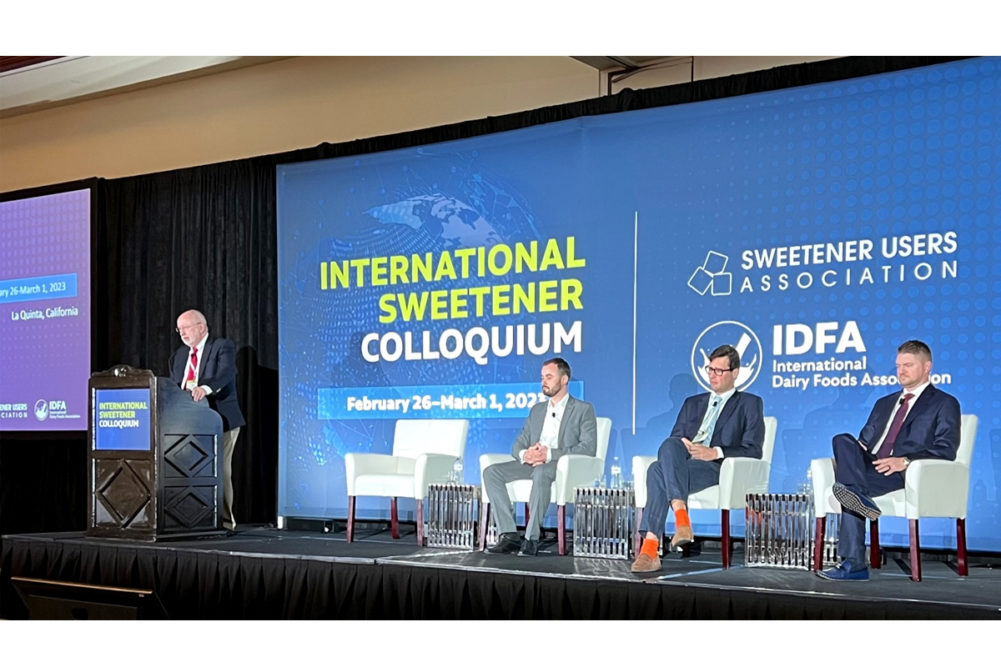LA QUINTA, CALIF. — Despite the bearish indications of surplus sugar and potentially weaker prices, panelists at the International Sweetener Colloquium in La Quinta, Calif., on Feb. 27 painted a mixed picture for the 2023-24 global sugar market outlook.
While analysts expect a global sugar surplus in 2022-23, some have been trimming their forecasts due to lower-than-expected production in some key countries. Forecasts of sharply higher production in Brazil in 2023-24 (crop year begins April 1) is expected to offset some of the declines in the current marketing year that runs from October to September for Northern Hemisphere producers.
Regardless of the surplus, analysts expect sugar prices to remain elevated, although not necessarily at current six- or seven-year highs. The crop in India, the world’s second-highest sugar producing country behind Brazil, is expected to fall short of earlier 2022-23 production forecasts. Several other major producers, except for Thailand, also were projected to have lower year-over-year production levels.
“When we look at global consumption, an almost five million tonne buffer in the forecast is not that much, especially with the risk of weather,” said Vincent O’Rourke, trader and market analyst at C. Czarnikow Sugar, Inc.
Data showed consumption had recovered to pre-pandemic levels, and analysts believed growth would likely continue and possibly even outpace production.
“The big dog at the table has been India,” Mr. O’Rourke said. “The rumors are the crop will be disappointing, and its conversion commitment to ethanol is interfering, so it’s possible India won’t meet its export forecast.”
India produced a record amount of sugar in 2021-22, but through its country’s incentivization program, mills began diverting more of its cane crop to ethanol production, said Sergey Chetvertakov, senior associate at S&P Global Commodity Insights. And after an extended monsoon season, its 2022-23 crop is expected to produce disappointing yields.
“The world has become accustomed to India’s sugar exports, but that won’t be the case in five years with increasing ethanol production likely to continue,” Mr. O’Rourke said.
Eyes looked to the potential 2023-24 large crop in Brazil to fill in the anticipated gap left by India. Though the country uses about 55% of its sugar cane to produce ethanol, prices are not competitive for ethanol production, and ideas were the crop would prioritize sugar production unless another situation similar to the invasion of Ukraine occurred, which would swing the spotlight to generating fuel supplies.
Despite being more competitive than ethanol, sugar production in Brazil offered weaker price margins when compared to other crops, which provided a bullish element.
“Unless we see prices come up, then no one will look at cane as a smart Investment,” Mr. O’Rourke said. “We really need higher prices, especially for Brazilian mills so they can increase their cane acres and sugar production.”
Thailand, another leading global sugar producer and exporter, was forecast to increase sugar production from a year earlier. But after the previous year’s devastating crop, the current production outlook was viewed more as a bounce back rather than trend upwards.
Adding to the strain of current global supplies was the nearly one-million-tonne shortage in sugar production from the European Union, the world’s largest supplier of beet sugar. A mild winter followed by extremely hot and dry summer conditions created a stressful environment for its crop. But the situation was further exacerbated by a scourge of beet yellow virus, likely linked to the EU’s recent ban on neonicotinoid insecticides, which have been blamed for killing bees. More tolerant and pest-resistant plant breeds were being developed but were not yet available, so analysts expected challenging seasons were still ahead for European beet sugar producers.
Another impact on the global sugar outlook was the late January ransomware attack on the Dublin-based ION Cleared Derivatives digital trading platform, which occurred while the New York No. 11 world raw sugar futures were rallying to seven-year highs.
“We had to manually figure out where the hedge funds and world sugars were positioned because that flow influences market prices, and the cyber-attack caused a break in that flow of information, and the ramifications on the commodities market from that break was astounding,” said Jeff Dobrydney, senior vice president and head of futures and options at JSG Commodities.




